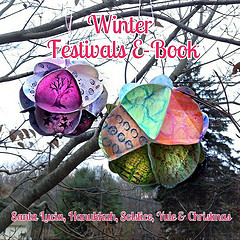Lent and Sacrifice
Today is the first day of Lent. At 39, I’m still negotiating my way through and around the beliefs and rites of my childhood. I think I’m not alone in this. One thing I do know is that I enjoy examining the whys and wherefores of traditional holidays, taking what I like and incorporating it into my family life, and leaving the rest behind.
The forty-day period of Lent begins with Ash Wednesday and ends at Easter. Lent is observed in the Roman Catholic Church and some Protestant churches, and is a generally a period of fasting, as it recalls Christ’s forty day fast in the wilderness. It is traditional for people to fast during Lent, giving up rich foods such as meats on Fridays, or other special favorites. Lent provides an opportunity for self-denial, simplicity, and penitence—a kind of spiritual “spring cleaning.” The very name Lent is derived from the Germanic word for springtime.
Giving up something you love for a period of time is a kind of sacrifice, a discipline that you can choose to impose upon your life out of religious conviction and a desire to become closer to Christ through deprivation. For people who aren’t Christian, Lent offers a means of meditating on the differences between needs and wants, separating out those things that are nonessential to your life and true happiness.
Sacrifice is both comfortable and odious to many parents and teachers of children. We often must place the needs of others ahead of our own needs in caring for children and people in need. We are often aware we have sacrificed small things on the altar of our family ideals, such as late-night movies or fancy vacations. Our lives, whatever they were before, were immeasurably changed the moment we became parents. We gave up things we were, and gave up things we did. We may even feel we have sacrificed in big ways, perhaps our own personal goals or dreams, on behalf of the family we are blessed to have. Realizing what we have given up or put on hold “for now” or indefinitely can be a slap in the face; it can bring up feelings of dismay or discouragement. It can make us feel resentful.
Contemplating our own sacrifices in life may be uncomfortable. It is, however, a worthwhile endeavor. It can lead to clarity about ourselves, our values, and our life’s goals. It can lead to a greater appreciation for what we do have. We can ask ourselves, what have we gained in return for our sacrifice? What paths are we now walking that were closed to us before? What lessons have we been given, by virtue of our self-denial?
Lent is a perfect time for this kind of contemplation, whether your purpose is to become closer to God, or to accomplish a little “spring cleaning” of your psyche. Lent is usually observed in three ways: fasting, almsgiving (charity), and prayer.
Fasting: Imposing a small restriction on yourself, whether it is literally or figuratively a fast, can sharpen your awareness, making you more mindful of your thoughts and actions and whether they are in line with your values. Here are some ideas for fasting; you can decide if they are appropriate for yourself only or for your whole family:
- Give up meat on Fridays during Lent, and on Ash Wednesday and Good Friday
- Give up drinking alcohol or eating foods containing sugar for the whole period of Lent
- Give up smoking for good and forever
- Give up drinking coffee or tea
- Give up your favorite other food
- Give up watching TV and/or movies during Lent
- Give away items you don’t really need, such as clothing, toys, and housewares
Almsgiving: Another way of observing Lent is to do something positive in the world. Finding ways to help others, donating time or money to charity, and cultivating an attitude of kindness and generosity toward people who are both intimates and strangers are other good ways to explore the idea of sacrifice. Give of yourself. You already know how to do this, but put some extra effort into it. The obvious place to start is in the home, so use your heightened Lenten awareness to practice acts of kindness and gentle words. You will gain more than you lose.
- Donate money to a charity that helps people who have less than you do
- Volunteer time to help an organization you respect
- Help your neighbors in some way, perhaps with carpooling or yard work
- Dedicate an hour or two of special one-on-one time with each member of your family
- Prepare a meal or bake a cake together as a family, then give it away to someone who needs it more than you
Prayer: Lent can be an opportunity to develop a habit of daily prayer, and there are numerous liturgies used for this purpose. Set aside some time every day to pray, think, or meditate. Not everyone is comfortable praying, but one form of praying that may work for you is called “contemplative prayer.” It is a kind of quiet meditation in which one listens for God, or Source, or one’s own heart to speak in the stillness. Pay attention to that voice.
- Find a few moments every day to sit quietly and listen to whatever rises within you; be kind to yourself even if what rises doesn’t seem “prayerful”
- Read from scripture; there are many prayers specific to Lent
- Read a poem in praise of nature or humanity; perhaps read the same poem every day or find a book of inspiring poems and read one each day
- Meditate on Rudolf Steiner’s Calendar of the Soul verses
- Choose a historical figure that you deeply admire and read a biography about that person’s life; notice his or her struggles and sacrifices
- Incorporate a morning or evening verse into your family’s daily rhythm; one that invokes our highest selves and our sense of wonder is appropriate
Finally, you can draw on examples and symbols of sacrifice from myth, religion, and human history to inspire you. Consider adding such symbols to your nature table, home altar, or place of prayer/meditation. Such visual symbols might include:
- Jesus or Buddha
- Mohandas Ghandi, Mother Theresa, Martin Luther King, Jr., Nelson Mandela, or other such historical figure
- A favorite saint; many were martyred and made the ultimate sacrifice for their faith
- An ancestor who serves as a role model and/or who made sacrifices on behalf of your family
- Purple cloth (purple is a traditional color of Lent)
- A portion of a meal set aside as a sacrifice (as is practiced in Buddhism and Hinduism)
- An image of Persephone, Greek goddess of the springtime, who sacrifices herself for a portion of the year to live in the underworld and minister to the dead
- Flowers, incense, grains, or seeds
- A lamb (Christ is often called the “Lamb of God”); lambs are symbols of innocence and often served as sacrifices in the ancient world
- A pelican; a medieval myth about the pelican made the bird a symbol of sacrifice (when mother pelicans returned to the nest to find their hatchlings slain, they pierced their own breasts with their beaks, and the blood of their wounds revived their offspring)
- Personal symbols of something you have freely given up for the sake of someone else

Whatever you choose, place these symbols intentionally and spend a moment or two each day looking at them. They will speak to you as you move through the season of Lent.
Feel free to leave a comment and tell me if and how you observe Lent. Are your observations traditional or ones you’ve invented for yourself? How do they help or serve you? I love to hear from you.
* This article was originally published in the Little Acorn Learning March Enrichment Guide.









February 22, 2012 at 12:04 pm
Well-stated, as usual. Even though I am obligated to do all of these things year-round, I feel a better spiritual “push” during Lent and Advent. I have always told the kids they don’t have to give up something, and that they are doing more of a physical/spiritual housecleaning and hopefully it will remain in them throughout the year. It’s almost like two times to check in with yourself- hey, you still doing the right thing? I don’t usually say what I give up/do- I figure it’s between me and my maker, but if the kids give up something (like chocolate) I make sure it’s not around to tempt them. We usually clear out the pantry and donate food/toys/clothes/etc. now. Also, other non-Roman Catholics that are in communion with the church follow the lenten traditions. (i.e. Byzantine) and the orthodox churches (not in communion). I love your postings, whether I agree or not!
February 23, 2012 at 8:23 pm
Great post, Sara! I just finished a link post for my own blog tomorrow, but now I have to go and add this to it! I plan to write about Lent soon, but just haven’t had the mental energy this week.